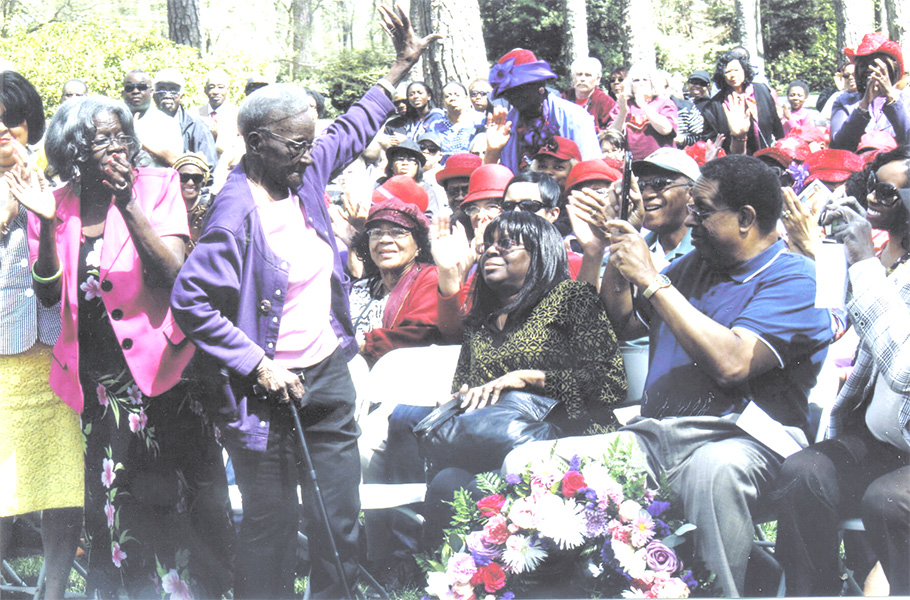Black Arts and Culture
Remembering 200 Women Who Created Garden

By New Journal and Guide Staff
Mrs. Mary Ferguson of Norfolk was the last known person to have helped construct the Norfolk Botanical Garden (NBG) during the recovery period of the nation’s Great Depression. She passed at the age of 97 in 2017.
Her story is one that is entwined with 199 other African-American women and 20 African-American men who were employed as WPA (Work Progress Administration) workers in 1938. Their assignment was to clear dense vegetation and plant the first azaleas around what is now called Mirror Lake. In just one year, thousands of azaleas, rhododendrons, shrubs and trees were planted. That beginning developed into today’s oasis of 53 themed gardens encompassing 175 beautiful acres.
Mrs. Ferguson was one of 58 workers identified in recent years after a search project to collect the names of the 220 workers was instituted by Norfolk Botanical Garden (NBG). However, to this day, others of the workers remain anonymous.
In 2009, NBG unveiled a commemorative sculpture Breaking Ground and dedicated the WPA Memorial Garden to honor and celebrate the contributions of the African-American workers whose labor created the Garden.
For decades despite the Norfolk Botanical Garden being depicted in images nationally, few African-Americans and whites knew about how the Garden was built.
Dr. Martha Williams penned a book on the history of the Black men and women workers entitled “Norfolk Botanical Gardens: WPA Untold Story.”
In a 2016 New Journal and Guide article announcing her book, Williams said her research on the garden’s history led her to the Journal and Guide archives.
While she was doing her initial research, she discovered the story behind the lives and contributions of the 200 Black women was colored by the legacy policy of Jim Crow segregation. It is a story that was documented in the pages of the Journal and Guide in 1938.
Williams referenced a January 22, 1938 edition of the Journal and Guide, which described how angry the Norfolk Black Community was about the working conditions the women endured during those initial stages of the garden’s development.
“There was a picture of the Black women in big coats (in the cold) pushing wheel barrels and shoveling dirt,” said Williams. “Black leaders were outraged because they said such work was not for women, but men or better still – mules.”
According to Dr. Williams, the Black women laborers moved more than 125 truckloads of soil using shovels, buckets, and wheel barrels in cold and hot weather.
Dr. Williams said during the early days of the WPA in Norfolk, many Black women were hired for a sewing room at Norfolk Community Hospital.
But one Friday they were told the sewing room project had run out of money and they were no longer needed.
A week or so later, however, white women were hired for the sewing project at another site. At the same time, the Black women were transferred to the Municipal Garden Project.
“They believed Black women were more suited for such work,” said Martha Williams, whose book chronicles how the Garden’s complex was originally developed. “It is now is a tribute to those women who worked to feed their families and only recently got the recognition they deserve,” said Williams.
“A group of Black leaders went to Richmond to complain to WPA regional officials about the conditions,” she said. “But they did not get any response from them.”
Williams said subsequent Guide articles reported the Black leaders also complained to Norfolk Social Services and WPA leaders in Norfolk about the working conditions of the women.
“I read in a publication sponsored by the city’s Chamber of Commerce called ‘Civic Affairs’ which explained why these women were selected for the job,” said Williams. “The article said the ‘colored’ women were on relief (WPA) to help them make money. Also they said that the Black women were best suited to do the job because they were used to ‘stooped’ work … bending over working the vegetable field at the many farms in North Carolina and Virginia.”
“But these ladies did not want a hand out,” said Williams. “They were working to support the families. The wages were 25 cents an hour and in two weeks, they would earn about $17.”
Indeed many of the women who were among those who worked at the Garden also toiled collecting spinach, strawberries and other vegetable crops at nearby farms.
Further, many of the women had received formal training at Virginia State or at Norfolk’s Mission College, both of which served the Black community during Jim Crow.
Williams said that only 58 of the 200 women who worked from 1938 to 1941 have been identified. Mrs. Ferguson was the last living one of them. In Williams’ book she has written bios of varying length of only 24 of them. She wants to expand that number.
Mrs. Mary Ferguson would have been 98 on May 15, 2017.
This article is based on a longer story by Chief Reporter Leonard E. Colvin that appeared in the New Journal and Guide in April 2017.














